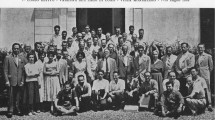Abstract
Creativity in theoretical physics is illustrated by breakthroughs ranging from the creation of the calculus by Newton to the invention of the neutrino by Pauli. The natural language of science is mathematics. Sometimes, physicists must expand this language, and usually, they take clues from it and its severe constraints.
Access this chapter
Tax calculation will be finalised at checkout
Purchases are for personal use only
Similar content being viewed by others
Notes
- 1.
Ptolemy is an exception that proves the rule. His remarkably accurate tables for planetary motion were a tour-de-force of curve fitting. His rules of motion simply dictated using layers of circular motion, epicycles. His epicycles must be routinely updated, and each new solar system requires its own precisely tuned epicycles. It might seem universal if you only know about circles but it is not.
- 2.
This was really a rediscovery, as it was even known by some Greeks.
- 3.
It took Newton several years to define the center of mass, a precise definition for the point displayed in Fig. 5.1.
- 4.
Until they do. Eventually, we get to the details.
- 5.
Very few universal constants are known to twenty significant figures.
- 6.
Unless we look.
- 7.
This is drastically oversimplified.
- 8.
This last part became so difficult that physics divided into theoretical and experimental physics.
References
Aristotle (350 B.C.E.). Physica.
Aristotle, Ross, W. D., & Hardie, R.P. (1962). Works of Aristotle: Physica. Oxford: Clarendon Press.
Copernicus, N. (1543). De Revolutionibus orbium coelestium.
Copernicus, N. (1959). De revolutionibus orbium coelestium, 1543. On the revolutions.
De Broglie, L. (1924a). Recherches sur la théorie des quanta. Ph.D. thesis, Sorbonne, Paris, France.
De Broglie, L. (1924b). Recherches sur la théorie des quanta (Doctoral dissertation, Migration-université en cours d’affectation).
Descartes, R. (1637). Discourse on method, optics, geometry and meteorology.
Descartes, R. (1637/2006). Discourse on method, optics, geometry, and meteorology. New York: Oxford University Press.
Descartes, R. (2001). Discourse on method, optics, geometry, and meteorology. Indianapolis: Hackett Publishing.
Einstein, A. (1905a). Zur Elektrodynamik bewegter Korper. Annalen der Physik, 17, 891.
Einstein, A. (1905b). Zur elektrodynamik bewegter körper. Annalen der Physik, 322(10), 891–921.
Einstein, A. (1905c). Uber einen die Erzeugang und Verwandlung des Lichtes betreffenden heuristischen Gesichtspunkt. Annalen der Physik, 17, 132.
Einstein, A. (1905d). Über einen die Erzeugung und Verwandlung des Lichtes betreffenden heuristischen Gesichtspunkt. Annalen der Physik, 322(6), 132–148.
Galilei, G. (1953). Dialogue concerning the two chief world systems, Ptolemaic and Copernican. New York: Random House LLC.
Galileo, G. (1632). Dialogue concerning the two chief world systems.
Maxwell, J. C. (1863). A dynamical theory of the electromagnetic field. Proceedings of the Royal Society of London, 13, 531–536.
Maxwell, J. (1865). A dynamical theory of the electromagnetic field.
Newton, I. (1687). Philosophiae naturalis principia mathematica.
Newton, I. (1687/1999). Philosophiae naturalis principia mathematica. Berkeley and Los Angeles: University of California.
Newton, I., Bernoulli, D., MacLaurin, C., & Euler, L. (1833). Philosophiae naturalis principia mathematica (Vol. 1). excudit G. Brookman; impensis TT et J. Tegg, Londini.
Pauli, W. (1930a). Public letter.
Pauli, W. (1930b, December 4). Letter to a physicists’ gathering at Tubingen. In R. Kronig & V. Weisskopf (Eds). Collected scientific papers (Vol. 2, pp. 1313).
Schrödinger , E. (1926a). Quantisierung als eigenwertproblem. Annalen der Physik, 79, 361.
Schrödinger, E. (1926b). Quantisierung als eigenwertproblem. Annalen der physik, 385(13), 437–490.
Author information
Authors and Affiliations
Corresponding author
Editor information
Editors and Affiliations
Rights and permissions
Copyright information
© 2015 Springer-Verlag London
About this chapter
Cite this chapter
Perry, R.J. (2015). Creativity in Theoretical Physics. In: Charyton, C. (eds) Creativity and Innovation Among Science and Art. Springer, London. https://doi.org/10.1007/978-1-4471-6624-5_5
Download citation
DOI: https://doi.org/10.1007/978-1-4471-6624-5_5
Published:
Publisher Name: Springer, London
Print ISBN: 978-1-4471-6623-8
Online ISBN: 978-1-4471-6624-5
eBook Packages: EngineeringEngineering (R0)



